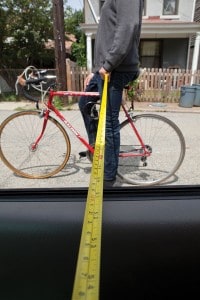“It’s not being enforced to the extent it should be.”

City Paper | Heather Mull
According to research by the Pittsburgh City Paper, only twelve violations of Pennsylvania’s four foot passing law were recorded in Allegheny County in the past two years. But there may be some solutions on the horizon. Police officers in Austin, Texas are taking commendable, low-tech measures to better enforce their state’s 3-foot law while researchers at CMU are exploring high tech solutions to the age-old problem of cars passing bicyclists with too little space.
By Alex Zimmerman
It isn’t often that lawmakers spend years shepherding legislation they know will likely not be enforced.
Yet when it came to state Rep. Ron Miller’s “Safe Passing” bicycle bill — a law designed to give cyclists a buffer from drivers — that’s exactly what he foresaw.
“From day one, we suspected it would be very hard to write citations, because it’s a judgment call” for law enforcement, says Miller, a York Republican.
Overwhelmingly passed by the legislature and signed by Gov. Tom Corbett in February 2012, the law was celebrated as a win by many bike advocates, who have successfully lobbied 25 state governments nationwide to pass similar measures.
“The state of Pennsylvania took a huge stride toward improving our Bike Friendly State standing,” declared local advocacy group Bike Pittsburgh the day after Corbett signed the legislation.
The law requires cars to allow 4 feet of space when overtaking bicycles, and to pass at a “careful and prudent reduced speed.” Drivers are barred from the right or left “hook,” a maneuver that cuts off bikers by turning in front of them. And bikers must “use reasonable efforts so as not to impede the normal and reasonable movement of traffic.” Violating the law is a summary offense — in this case, a $25 fine.
But as in many states with safe-passing laws, enforcement in Pennsylvania has been spotty: Just 42 citations have been issued statewide since the law took effect 28 months ago, 12 of which were recorded in Allegheny County, according to a City Paper review of court data. And it’s not clear if the law is having a significant effect on the number of car-related bike crashes.
“It’s not being enforced to the extent it should be,” Bike Pittsburgh executive director Scott Bricker says today. “After two years, you would hope that tool would be used more often.”
So why have so many politicians and advocacy groups bothered to pass bike-safety laws that are often unenforced and, some argue, unenforceable?
Read the full article in the Pittsburgh City Paper.